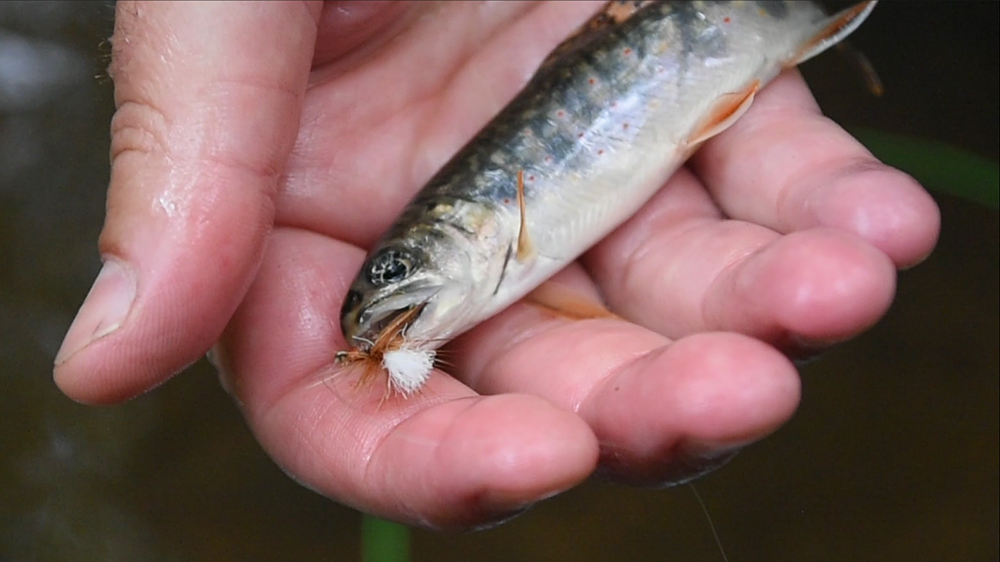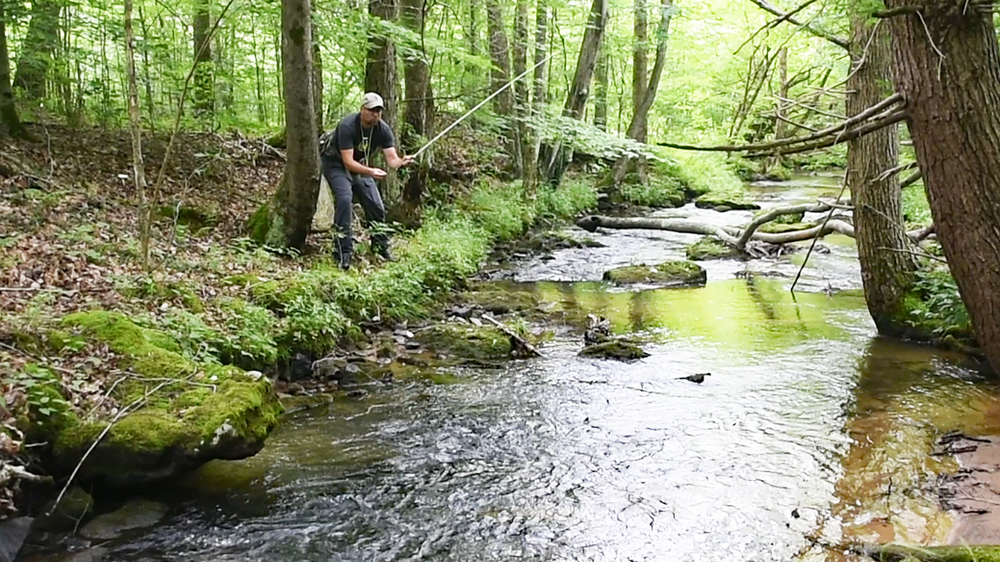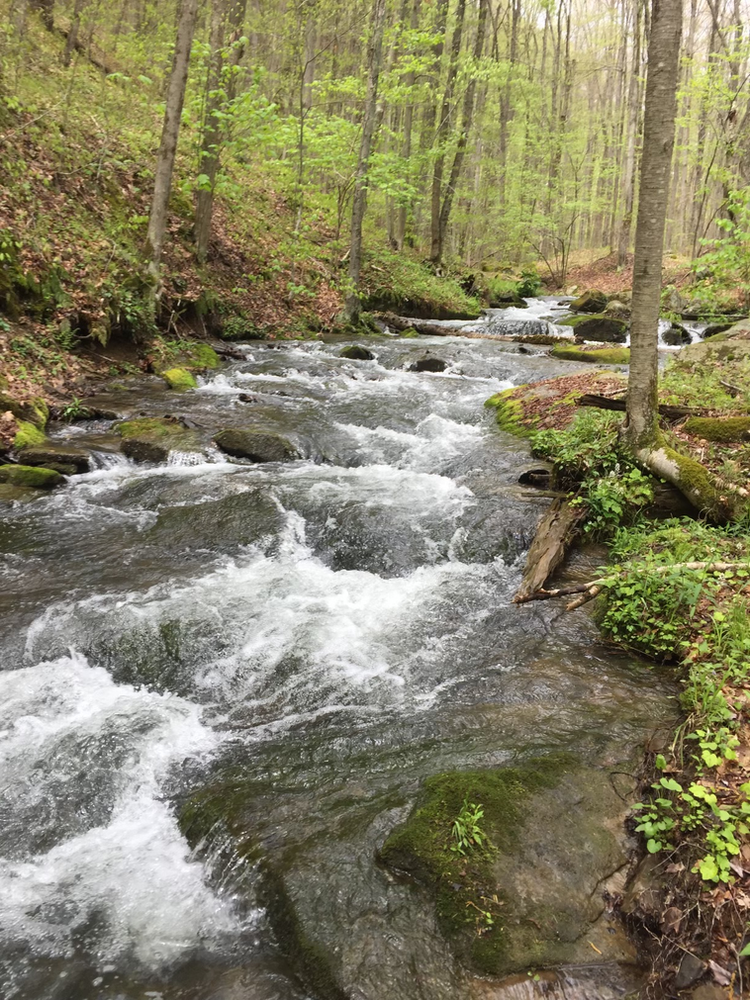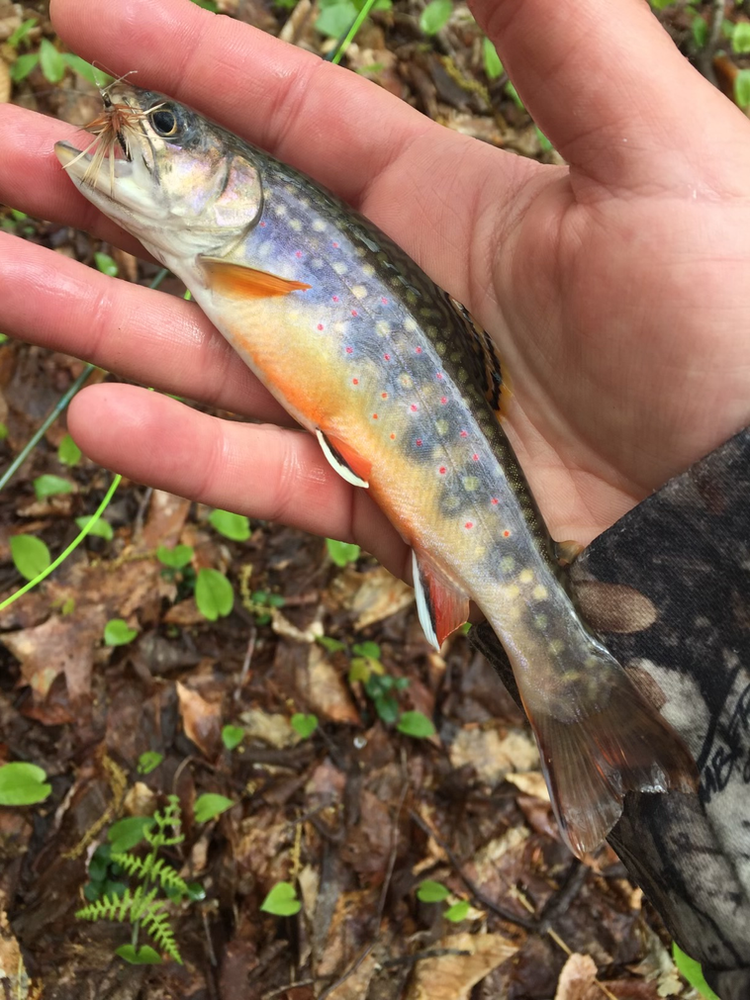Dog Days Brook Trout on a Cameron County Class A Stream

Cameron County is often coined “The Hidden Gem” of The PA Wilds. Having a family cabin in this region, spending many days every year fishing and hunting here, I have to agree. Numerous ice cold, Class A mountain trout streams make Cameron County a great place to spend some time chasing native brook trout any time of year, even in the dog days of summer.
If northcentral Pennsylvania is known as the “Dark Skies Region,” then Cameron County is surely “deep space.” Cameron is the least populous county in the state with 4,547 people as of 2020. To put that number in perspective, Pleasant Hills, the suburb of Pittsburgh that I live in, is 2.78 square miles and has a population of 8,504 people. This is wild, desolate country, ideally suited for brook trout.
Cameron County boasts a remarkably large percentage of public land and rugged beauty as a result of three state parks, four designated natural areas, a majority of Elk State Forest, two state game lands and the Quehanna Wild Area. The county has only five state thoroughfares with primary paved roadways being PA 555, 120, 155, 46 and 872. There are miles upon miles of public use dirt/gravel forest roads maintained by the DCNR.
Within the hundreds of thousands of acres of public land in Cameron County are countless sections of Class A wild trout streams. If fishing small streams for wild browns and native brookies is appealing, then this is surely a destination county. And, this is exactly why I was bumping along an isolated forest road in my friend Ralph’s late model, not-so-well-taken-care-of Tacoma in late July.
A Note About Summer Small Stream Fishing
Anglers must take care when choosing to fish small Class A streams during summer. High summer can be a very challenging time for small stream wild fish as a result of low, clear flows that leave fish vulnerable to predation. Also, as air temperatures climb, so can water temps on many small streams. When water temps are approaching the high sixties, then it is best to leave the fish alone until more favorable conditions arrive. Additionally, if the stream is low and gin-clear, choose not to fish that day despite water temps.
Only target small streams during the months of July-September following significant rain events. Ethical and good fishing can be had when storms add water, lowering temperatures and raising the turbidity. Ralph and I were fishing twenty-four hours after thunderstorms struck the region providing exceptional summer fishing conditions.

Summer brook trout fishing is a whole other world than springtime brookie fishing.
A Simple Plan
The plan was to fish a small state forest Class A, an exclusive native brook trout stream, that I have fished countless times and consider one of my home waters. Ralph planned on filming while I provided the fishing footage and commentary (look for that video in the near future). I felt overly confident that we would nail good numbers of willing and naive brookies.
Generally speaking, brook trout aren’t selective. They’ll eat any buggy dry fly that is presented well. However, their discerning eye picks up the slightest bit of drag, especially during lower summer flows. Still, the greatest challenge of catching native brookies is usually not spooking them. Again, that sounds simple, but it can be incredibly difficult to pull off this time of year.
My introduction for the video we intended to make about that day’s fishing started out mentioning all of these things. I didn’t realize how prophetic those words would be, though. Dog days brook trout aren’t easy!
The native brookies schooled and humbled me that late July morning. Made me look like an absolute fool! Yes, I brought some fish to hand, but I also missed a truck load of them and witnessed numbers of flat-out refusals. These native brookies were behaving more like pressured browns in a number of ways and I was dumbfounded. They were completely different fish from when I fished this stream with my buddy, Bill, in early May.
These brook trout taught me a lot that late July morning, and for this I am appreciative as an angler who’s continually working on honing his craft. As a result, based on my observations, I have made three inferences that explain why dog days brookies are a far different creature than springtime brookies.
1. Low Water and More Predators
A crucial fact remains that northcentral Pennsylvania small streams and tributaries rise and fall with every passing rain shower. These freestoners rely on receiving water as it runs off of the mountainsides during precipitation. As the groundwater is recharged, it reappears cold, 52 degrees fahrenheit at this latitude, and clean at the earth’s surface in countless spring seeps.
These springs flow downhill, eventually discharging into small tributaries providing wild trout with the clean, cold water. During periods of regular snow melt and soaking rains, life is good for wild trout in Class A mountain streams. Nevertheless, during dry spells, life becomes a struggle for aquatic insects, amphibians, crustaceans and fish, namely native brook trout and wild browns.
It is during these periods of low, clear water that wild trout become easier targets for numerous avian and terrestrial predators. Raccoons, mink, otters and possibly even black bears prey on trout during lower water flow periods. Common avian predators include kingfishers, blue herons and mergansers. Northern water snakes will not hesitate to take brook and brown trout fingerlings either! As a matter of fact, while filming our morning on the water, Ralph and I noticed raccoon tracks in the muddy bank margins and observed several kingfishers.
With all of these wild animals searching for a fish dinner, it is not surprising that brook trout become paranoid critters. How can they not be with so many others trying to eat them?
Low, clear water resulting in increased predation is the first inference that causes dog days brookies to be more challenging to catch. The aggressive little rippers that threw caution to the wind in May now have their heads on a swivel. They become unconditionally spooky and cagey!
Fishing downstream into them is impossible. Casting a shadow on the water or placing fly line over their heads sends them scurrying under a rock or log or tucking into a root ball. Simply wading in the water, albeit carefully, creates ripples and vibrations that telecast danger, danger, danger. Approaching these cagey fish to make a cast and present a dry fly is unequivocally more challenging during summer stream conditions.

During springtime, higher water flows and more insects are a perfect combination for “less challenging” native brook trout fishing. Dogs days brook trout, though, are a different story.
2. It’s a Jungle Out There
The second inference I’ve made as to why dog days brook trout are so challenging is that the forests are in full summertime growth. All of the trees are in full leaf-out, but they’re not the primary problem. The primary problem is stream-side weeds are at full height and low lying bushes and shrubs have grown larger and fuller. Approaching the stream, we bushwhacked through knee-high bracken, waist high stinging nettles, goldenrod and ragweed at our chests, and tangles of immature saplings and mature grape vines overhead.
This brush and foliage grows thick, tangled and matted, right up to the stream margins. Add to this the ubiquitous hemlock bows that reach and grope, snatching and devouring every errantly casted fly. Getting into a low profile, stealthy position to make a careful and precise presentation is more difficult than selling a bottle of water to a drowning man!
Stumbling, fumbling, and cursing, we battled the foliage and brush, tripped and fell down, and the brookies fled two counties over before we were 50 feet from the stream.
3. Where Have All the Insects Gone?
Flipping over several rocks, we found very few mature mayfly nymphs. The mayfly nymphs we did encounter were tiny and no larger than a lowercase letter found on this page. We found a few larger stick-cased caddis and smallish dark stonefly nymphs to go along with the empty shuck of a hellgrammite clinging to the trunk of a large hemlock tree.
There were very few aquatic insects to be found in a stream that is quite fertile for a freestoner in April and May. I have observed good hatches of mayflies, caddis, and stoneflies on this tributary in the past, including green drakes!
However, by late July, the last of the major hatches had subsided six weeks ago. The mayfly nymphs that we did encounter appeared to be the newly hatched, young-of-the-year broods. Their larger parents had since deceased after mating and egg laying or inhaled into the bellies of brook trout.
Fewer bugs hatching means summer brook trout aren’t geared to “look up” as much for food, and so they don’t attack surface presentations with the same degree of gusto as they might in the spring. Their behaviors that July morning told this story, too. Brook trout often slashed at the fly without inhaling it. Several times, I observed fish rise up from the bottom, examine the fly, and then slowly turn away. These are the behaviors of heavily-pressured wild brown trout, not typical native brookies! Where did the feisty little rippers I fished for in April and May go?
The fact is that these July fish were the same exact ones. They were not behaving the expected way because of increased angler pressure — I’m convinced the only angler that fishes this particular tributary is me. They were behaving this way because they had become wary of large, surface food because these foods are abnormal for this time of year. I fooled a few to inhale my fly with vigor, but only when I achieved a perfect presentation with absolutely no micro drag whatsoever.
Additionally, the brookies largely ate the fly within 5-10 inches of the drift. Longer drifts did not produce many takes because they had longer to investigate the fly. The brook trout had inevitably become selective and challenging to catch.

Native brook trout rarely grow bigger than 7-9 inches, but for what they lack in size they make up for in beauty and grit.
Parting Words
Spending a morning on a small, Class A trout stream is a joyful experience to cherish any time of year. Just don’t expect to find the same easy-to-fool brook trout during the dog days of summer that you might find earlier in the season. Summer conditions offer a largely different experience compared to fishing these waters in springtime. Different, but not bad.
Not every fishing day goes as planned, or as hoped. Ralph and I had visions of catching and filming loads of feisty native brook trout, but that didn’t happen. Sure, we caught a few and had a great morning on the water. But more importantly, we learned more about fishing for these fascinating creatures and the struggles they endure to survive.
The greatest appeal of native brookie fishing, for me, is the way they dart out of nowhere to grab a dead-drifted dry fly and the beautiful settings and isolation in which they are found. Native brookie fishing in Pennsylvania is rarely a big fish pursuit; a big brook trout in this particular Cameron County stream would be 7-9 inches!
However, brookies are our fish. And they are remarkably gorgeous. For what they lack in size, they make up for in grit, determination and spirit. This is why I love fishing for them so much, even during the dog days of summer.
Did You Enjoy Reading This Post?
Stay up to date with the Dark Skies Fly Fishing monthly newsletter for free and receive the latest fly fishing news, tricks, tips, and techniques, stream reports, as well as updates on new flies added to the Online Store and exclusive discounts!
Sign Up Now
I just watched the video and finally with 30 seconds left I saw the real ME fishing for brookies: pulling my fly out of a branch, or in a log, or attached to something on shore that is not letting go. I enjoy fly fishing but I will let the little streams to the experts. I would have more fun walking along with the camera man and seeing the sites than trying to maneuver a fly rod along a native trout stream.
Hi JBordy,
Please take my advice and get out there on a mountain Class A and target small brookies and browns. You can absolutely fish these streams with success by making a few adjustments and altering your approaches. Like anything, it takes some practice, but I promise that you will get the hang of it. Additionally, foundationally, it is stripped down fly fishing that is not technical. And, trust me, I am FAR from an expert. This is clearly visible as Ralph strings together the series of clips showing me hung up in the trees, bushes and weeds! I have a passion for small stream fly fishing! For me, it is far more about the tranquility, isolation and wildlife encountered than the actual fishing. You will love it, too! We are here to help and answer questions, so drop us a line.
Justin
That was a nice read. And you went the entire way through the article and never mentioned the body eating bugs that attack from all directions, the rattle snakes that always live along these wonderful streams, and the spider webs that are always at face level. And a parting comment, “not every fishing day goes as planned” is suitable for any outdoor excursion. Keep up the good work.
Wow, thank you so much for reading and providing beneficial feedback on my article. I am super stoked that you enjoyed this passage about brookie fishing on small Class A streams. Coincidentally, I do talk about fishing in rattlesnake country in the companion video that corresponds with this article. I absolutely love timber rattlesnakes and cherish every encounter. Your comment concerning this is testament of your experience fishing remote trout streams in north-central Pennsylvania. And, yes, the small bugs that swarm your face filling your eyes, ears and nostrils, coupled with countless spiders hanging in their webs are also a distinct reality. I typically become quite accustomed to these residents readily, considering them my constant companions on these forested, wilderness streams. Have fun and be safe out there!